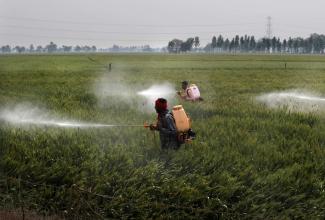Sustainability
Rethinking agricultural productivity
 picture-alliance/ASSOCIATED PRESS/Manish Swarup
picture-alliance/ASSOCIATED PRESS/Manish Swarup
Humanity is facing the challenge of feeding a growing world population with limited resources. This calls for increasing agricultural productivity which is traditionally defined as producing more output (harvest) with the same input (area, soil, capital, labour) or the same output with less input. Economists refer to this as “total factor productivity” (TFP), a widely employed metric for comparing agricultural efficiency among nations and measuring progress.
However, TFP fails to consider the long-term effects of current agricultural practices on soil, biodiversity, health and people. This is a massive flaw, as increasing short-term productivity may jeopardise conditions for future productivity in many ways. For example, the current use of intensive tilling methods can harm the soil; fertilisers may cause health issues; and the humus layer may deteriorate due to insufficient regeneration periods. By neglecting these concerns, TFP presents an incomplete picture.
For example, in the 1960s, India initiated the “green revolution” in response to two famines. Geneticist M. S. Swaminathan spearheaded this effort, introducing high-yielding wheat and rice varieties in the western region of Punjab. This aimed to boost productivity, resulting in record-high output. India’s “green revolution” is praised for successfully feeding the growing population and reducing rural poverty.
Negative consequences of India’s green revolution
Decades later, however, the adverse effects are increasingly evident. Punjab, once known as the “land of five rivers” is projected to transform into a desert within 25 years due to the water-intensive cultivation of rice. Continued soil degradation, declining health and reduced seed variety pose persistent challenges. Moreover, the climate crisis is making wet and dry seasons less predictable.
Severe social consequences ensued too. Farmers are forced to buy expensive genetically modified seeds and fertilisers from major corporations to grow crops on depleted soil. As a result, many of them have incurred substantial debts, leading to tens of thousands of suicides every year. Additionally, Punjab has gained notoriety as India’s “cancer capital” due to the widespread use of hazardous agrochemicals.
Despite all this, metrics such as TFP suggest that India’s productivity increased following the green revolution. They focus on short-term economic output rather than long-term net gain for the planet and people and fail to take into account potential long-term destruction. However, if agricultural practices undermine the sustained productivity of nature or people, hindering people’s ability to lead fulfilled and healthy lives, they should not be labelled as productive.
Productivity versus reproductivity
There is a growing consensus that a shift in perspective on agricultural productivity is necessary. Instead of focusing solely on short-term surpluses, we should assess how agricultural practices can be reproduced in the future. Therefore, it is more appropriate to consider the term “reproductivity” rather than “productivity”.
The conversation around agricultural productivity is shifting towards more sustainability. There is a growing interest in re-designing agricultural systems in the name of agroecology, permaculture, agroforestry and regenerative agriculture. Moreover, there is a strong emphasis on involving local communities in decision-making processes.
Measuring ecological and social sustainability
The challenging question is how to measure agricultural (re)productivity, regenerativity or sustainability. Obviously, it requires a much broader time frame, but quantifying long-term consequences is difficult due to the inaccuracy of current climate models. The complexity increases when considering long-term ecological and socio-economic effects.
However, farmers adopting more sustainable methods need to monitor progress. Data providers use modern technology to quantify soil functional biodiversity and the potential to store water and carbon. While quantifying soil biodiversity is rather complex, measuring above-ground biodiversity effects is even more difficult. It requires various data points, such as satellite data, bio-acoustics and samples from environmental DNA (eDNA). Making assumptions about future developments is also necessary.
Financing is crucial
Quantifying sustainable agriculture is essential for attracting financial rewards from political schemes, customers and investors. This is crucial because agricultural (re)productivity needs to be sustainable regarding finance too. Simply telling a farmer that a change in practices will start paying out in ten years, but will decrease yields for the next five years, is not a compelling argument without schemes guaranteeing compensation in the meantime.
Recent developments in the debate on payments for ecosystem services provide hope for innovative rewards for farmers adopting reproductive practices. However, we are still at the very beginning of a new productivity regime, and there is much work ahead. We can start by redefining India’s green revolution not merely as a period of productivity gain but as a lesson on how not to measure agricultural productivity in the future.
Literature
Schragmann, H., 2024: Produktivität neu denken. Vom Trennungs- zum Vermittlungsbegriff (“Rethinking productivity. From the concept of separation to the concept of mediation” – available in German only). Springer.
Hannah Schragmann holds a PhD in Economics, focusing on new productivity metrics. She is Chief Transparency Officer of Impact Hero, an impact start-up, and Head of Biodiversity at Soilytix, a business for soil biodiversity quantification.
hannah.schragmann@ethicsinbusiness.eu

